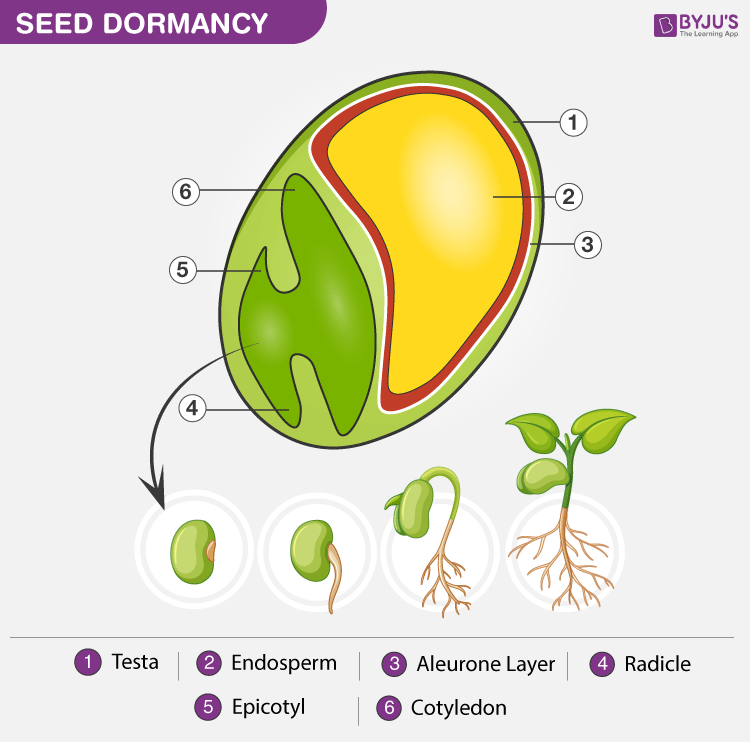Seed dormancy can be defined as the state or a condition in which seeds are prevented from germinating even under the favourable environmental conditions for germination including, temperature, water, light, gas, seed coats, and other mechanical restrictions.
The main reason behind these conditions is that they require a period of rest before being capable of germination. These conditions may vary from days to months and even years. These conditions are the combination of light, water, heat, gases, seed coats and hormone structures.
Also Refer: Seed Germination
Reasons or Causes of the Seed Dormancy

There are certain major causes for the seed dormancy. Listed below are the few reasons for the seed dormancy.
- Light
- Temperature
- Hard Seed Coat
- Period after ripening
- Germination inhibitors
- Immaturity of the seed embryo
- Impermeability of seed coat to water
- Impermeability of seed coat to oxygen
- Mechanically resistant seed coat
- Presence of high concentrate solutes
Types of Seed Dormancy
The seed dormancy is of following types:
Innate dormancy
It is the condition of seeds which is incapable of germination even if conditions suitable for seedling growth are supplied. This inability to germinate may be due in certain species to the embryo being immature at the time of dispersal.
Enforced dormancy
It is the condition of seeds which is incapable of germination due to an environmental restraint which includes, an adequate amount of moisture, oxygen, light and a suitable temperature.
Induced dormancy
This type of seed dormancy occurs when the seed has imbibed water, but has been placed under extremely unfavourable conditions for germination. Finally, seed fails to germinate even under more favourable conditions.
Methods of Breaking Seed Dormancy
The different methods of breaking dormancy are mentioned below:
The natural breaking of Seed Dormancy
Nature of dormancy stops when the embryo gets appropriate environment such as adaptive moisture and temperature. The seed coat that exists in many species becomes permeable due to the rupturing of smoothing action of natural agents like microorganism, temperature, and abrasion by the digestive tract of birds and animals that feed on these seeds. Other natural methods include:
- Completion of the over-ripening period.
- Leaching of inhibitors present in the seed coat.
- Inactivation of inhibitors by the supply of cold, heat, and light.
- Leaching of the excess and highly concentrated solutes from the seeds.
- Production of growth hormones which can neutralize the effect of inhibitors.
Artificial Overcoming of Seed Dormancy
Some of the artificial methods used for breaking seed dormancy are listed below:
- Action with hot water for termination of waxes, surface inhibitors, etc.
- Rupturing of seed coats by filing, chipping, or threshing through machines.
- Exposure to heat, cold or light, depending upon the type of seed dormancy.
- By applying Hydraulic pressure for 5 to 20 minutes in order to weaken the tough seed coats.
- Seed coats are treated with concentrated sulphuric acid for removing all traces of the mineral acid.
Treatment to break dormancy in seeds
There are separate treatments to overcome dormancy, and they are further divided into the following groups:
Seed coat treatment
These treatments make a hard seed coat permeable to water or gases either by softening or cracking. This process is called scarification. The treatment can be either chemical or physical in nature.
Embryo treatments
Stratification: The incubation of seeds at an appropriate low temperature over a moist layer before transferring to a temperature suitable for germination.
High-temperature treatment: Incubation at 40-50 °C for a few hours to a few days may have an effect in overcoming dormancy in some species. For instance, rice seeds treated with hot water at 40°C for at least 4 hours.
Chemical treatments
Plant growth regulators or other chemicals can be used in induced germination growth regulators.
Importance of Seed Dormancy
- It follows the storage of seeds for later use by animals and man.
- It helps in the dispersal of the seeds through the unfavourable environment.
- Dormancy induced by the inhibitors present in the seed coats is highly useful to desert plants.
- Allows the seeds to continue to be in suspended animation without any harm during cold or high summer temperature and even under drought conditions.
- Dormancy helps seeds to remain alive in the soil for several years and provides a continuous source of new plants, even when all the mature plants of the area have died down due to natural disasters.
Also Refer: Significance of Seeds and Fruits Formation
Dormancy of seeds is for a long time, which acts as a survival mechanism. Seed can adapt to adverse situations and resist inappropriate germination. But there is no uniform germination. Dormancy makes it difficult to maintain the plant population and interferes in seed testing procedure.
Stay tuned with BYJU’S to know more about Dormancy of seeds.
Also Read: Cryptobiosis

thanks for the info, It’s interesting and beneficial.
Using this app will help you to learn better and better.
it is useful materials for my students
so iam very happy if you can kind of this valuable things for me.
Dr. abdelbasit Elmagboul
Sudan University of Science, College of forestry and Range
Excellent job u did
Very useful information in summarised form. I need to reference this work. How do I do it
Thanks a lot for providing relevant information.
Very nice